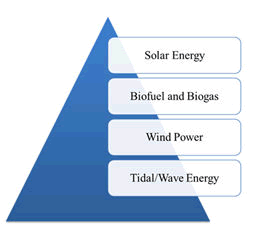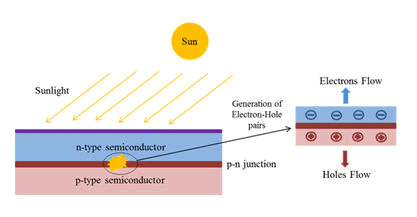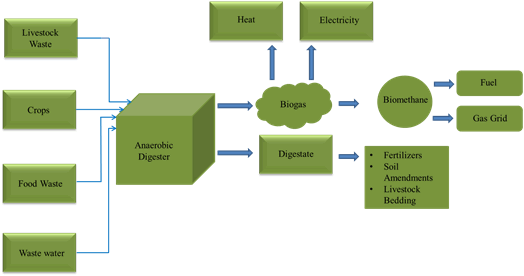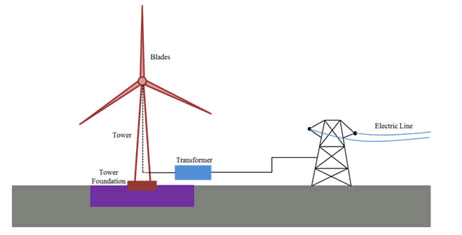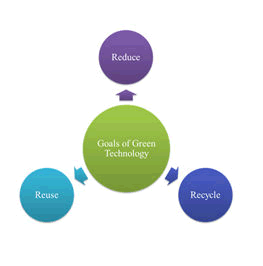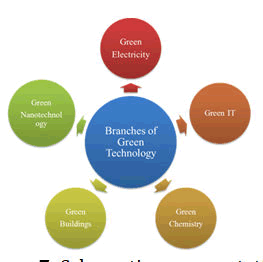Review Article, J Nucl Ene Sci Power Generat Technol Vol: 11 Issue: 4
An Overview of Green Technology and Its Aspects
Prasanna Mishra* and Gopala Krishna K
Department of Electronics and Communication Engineering, Jain (Deemed-to-be University), Bengaluru, India
*Corresponding Author :Prasanna Mishra, Department of Electronics and Communication Engineering, Jain (Deemed-to-be University), Bengaluru, India,E-mail: prasannamishra234@gmail.com
Received date: 03 November, 2021, Manuscript No. JNPGT-21- 46542;
Editor assigned date: 05 November, 2021, PreQC No. JNPGT-21- 46542 (PQ);
Reviewed date: 19 November, 2021, QC No. JNPGT-21- 46542;
Revised date: 03 January 2022, Manuscript No. JNPGT-21- 46542 (R);
Published date: 23 March 2022, DOI: 10.4172/2325-9809.1000258
Citation: Prasanna M, Gopala KK (2022) An Overview of Green Technology and Its Aspects. J Nucl Ene Sci Power Generat Technol 11:4.
Abstract
Green technology plays an important role for securing planet and its climate. Industrialization and growing population continuously negatively impacted on the environment. Emission of carbon dioxide (CO2) by industries at large scale and deforestation damages the environment that leads to the adverse effect on animals and human beings. Green technology can over such problems by utilizing the renewable energy resources such as solar energy, wind power and wave energy etc. Renewable energy resources help in minimizing the pollution by replacing the waste products by its recycled products. Deployment of the green technology has positive impact on environmental conditions as well as economy. By considering the importance of green technology, the aim of this review paper is to discuss about the green technology and its aspects. Green technology has great future in terms of potential that can be utilized to improve the environmental health and can help in economic development also.
Keywords: Ecosystem, Environment, Green technology, Renewable energy resources, Wind solar energy
Introduction
Climate change and global warming is the major issues in front of the world. Various government authorities and Non-Governmental Organizations (NGOs) are putting enormous effort in order to minimize the effect. Climate change is happening due to many reasons including increasing level of Carbon Dioxide (CO2) in the environment due to industries and other reasons are caused by rapid growth in population of the world. Growing population increases the demand of food and as well as infrastructure that leads to the deforestation. In order to survive, energy resources are the major part of our life these days [1]. Energy resources are utilized to provide the power to do any specific task. It helps in maintaining the life style. Energy resources can be used to produce heat, light and electricity that can be utilize in various activities such as cooking, lighting, driving the vehicles and so on. Most of the energy resources utilize natural gas, coal and nuclear energy (generally known as nonrenewable energy resources). But there are various disadvantages associated with these energy resources including it produces greenhouse gases, cause of acid rain, adverse effect on humans and animals and the residues are generally non-biodegradable. In contrast, green technology helps to conserve the planet and environment by utilizing its natural resources. Green technology uses renewable energy resources such as solar energy, biofuel and biogas, wind power and wave power. It significantly reduced the emission of Carbon Dioxide (CO2) in the environment. It offers various advantages as compared to the nonrenewable energy resources such as less maintenance, low cost, less dependency on foreign energy sources and has positive impact on human health as well as on environment [2]. Green technology offers different techniques in order to generate energy from renewable energy resources. Green technology significantly reduces the level of contamination and toxicity present in the surroundings or environment. It also helps in minimizing the global warming by reducing the emission of greenhouse gases and secures the ozone layer. This review article provides an overview of the green technology which utilizes various renewable energy resources for the generation of energy. It will also discuss about the various aspects associated with the green technology such as its goals, branches and advantages. This review article provides a good reference to the researchers who works in the field of environment and ecology.
Literature Review
Green technology and renewable energy resourcesGreen technology also known as clean technology and environmental technology that utilizes the renewable energy resources to produce energy. Renewable energy resources are referred to the energy sources that never end up or are endless or can’t run out that means these energy resources are sustainable. There is various renewable energy resources present in the nature as shown in the Figure 1. The detail of each renewable energy resources has been discussed below:
Solar energySun can be considered as a major source of energy that provides solar energy in terms of heat. Sun radiated solar energy and reach to the with huge amount of heat after traveling several miles. These days, solar energy has been widely used for the generation of electricity, in solar energy powered calculators, solar cooker for cooking and solar panels. Photovoltaic is one of the main applications of the solar energy [3]. Photovoltaic are used for producing the electric power by utilizing the solar cells to convert the heat energy that has been collected from the sun to the electric power due to the flow of electrons based on the photoelectric effect (as shown in Figure 2) [4]. When heat energy absorbed by the semiconductor material, there are large number of covalent bonds breaks resulting in generation of electron-hole pairs. These flows of the charge carriers lead to the generation of electricity. The main advantage of solar energy is that, it is available in large amount in the nature.
Organic matter waste generally generated by agricultural sector in large quantity. Earlier due to lack of knowledge, organic waste was not utilized properly. But now situation is completely different, now organic waste matter one of the major source of energy generation. There are various techniques has been explored by which organic wastes can be utilized in generation of energy. Biofuel is a mixture of gases that generated by the breaking down the organic waste in the absence of oxygen. Organic matter waste mainly comes from agricultural sector, food waste as well as manure etc. [5]. It negligibly produces Carbon Dioxide (CO2) due to which the environmental conditions are maintained to positive level. Rapidly decline in Carbon Dioxide (CO2) level in the environment makes earth’s climate more clean and secure. The best example of biofuel is Compressed Natural Gas (CNG) that has been widely used in motor vehicles these days. The petrol and diesel based vehicles produces more Carbon Dioxide (CO2) as compared to the CNG based vehicles. The process of anaerobic digestion is shown in the Figure 3.
Biogas or biofuel generated from biomass through the anaerobic decomposition process or process of thermochemical conversion. Biogas generally consists of methane (CH4) gas. Organic waste from plants or animals is known as biomass that has been utilized as a fuel to generate electricity or heat. There are various generations comes under the biofuels, first generation biofuels are generally made up from crops that has been considered as a food crop. Second generation biofuels are generally produced by biomasses. The third generation biofuel explores the alga culture and algae fuel.
Wind powerWind is an important renewable source of energy. Nowadays, many countries producing electricity by utilizing the wind power. In order to generate the electricity through wind power, wind turbines are connected to the blades that rotates when wind cross through it. It converts wind energy to the rotational energy that further converted to the electricity by the generator [6]. The electrical energy generation using wind power is shown in the Figure 4. There are various advantages of the wind power including no Carbon Dioxide (CO2) generation, simple equipment and easy installation and operation.
The electricity generation through the wind power is mainly dominated by size of the blades. Longer blades produce more electricity as compared to the shorter blades. The utilization of the different size blades depends on the how much electricity needed and the place where wind turbines have been placed. Longer blades increase the area of receiving wind that leads to the more electricity generation. There are various companies are focus on the electricity generation through the wind power in order to reduce the Carbon Dioxide (CO2) emission in the atmosphere. In many countries, farm lands are used to place the wind turbines because at that place the heavy wind flow cross through the blades. Apart from various advantages offering by wind power, there are some disadvantages also associated with this such as wind turbine’s blades can threat to wildlife and in order to set up the wind farm, deforestation takes place at large scale. During the rotation, wind turbines create loud noise that leads to the noise pollution.
Tidal/Wave energyAnother important renewable energy source is wave energy. Wave energy referred to the up and down periodic movement of the ocean’s surface. When wind cross over the surface of the ocean, the surface of the ocean gets up and down movement, this periodic wave movement utilizes to generate electricity [7]. The electricity generating equipment place over the surface of the ocean, when periodic waves come then there is a mechanical movement exerted on the equipment that converts the mechanical movement to the electricity (as shown in the Figure 5). Wave energy also referred as ocean wave energy or tidal energy [8].
Like other renewable energy resources, the wave energy also doesn’t emit the carbon dioxide (CO2); produce more clean electricity without harming the ecology. Apart from various advantages, wave energy also has some disadvantages. The list of merits and demerits are discussed in the Table 1.
| Merits | Demerits |
|---|---|
| Renewable | Suitable to certain locations |
| Environment friendly | Effect on marine ecosystem |
| Abundant and widely available | Weak performance in rough weather |
| Variety of ways to harness | Disturbance for private and commercial vessels |
Table 1: List of merits and demerits associated with the wave energy/ocean wave energy.
Goals of Green TechnologyFor fulfilling the need of the present situation, each technology set some goals in order to achieve the target. Like other technologies, green technology has also sets some goals (as shown in (Figure 6) in order to fulfill the need of energy for making the life easier to live. Green technologies main goal is to produce energy without harming the ecosystem. It usually utilizes to natural resources in order to produce ecofriendly products and it doesn’t require each time new resources for producing the energy. By using green technology, people can make planet greener and healthy that will help to improve the life of the earth also.
ReduceNonrenewable energy resources produce waste products that cannot be utilized for other purposes that lead to the damaging of environment. On the hand, the utilization of renewable energy resources in green technology generates no wastes by reducing or minimizing the production of waste resulting in conservation ecosystem and environment [9]. While producing energy through various resources, the waste product can cause of various dangerous diseases that has adverse effect on health of humans as well as animals. In this regards, this is one of the major goal of the green technology.
ReuseApart from no waste generation, another goal of green technology is to reuse the waste product by recycling process. The utilization of the wastes through the recycling process helps to secure our environment and surroundings that has huge adverse effect on natural environment. Recycling process helps in reducing the pollution due to the waste generation. Recycling also reduce the usage of fresh raw materials; minimize the emission of harmful gases and save energy as well as money. It also helps to use the products to their optimal extent.
RecyclingThe reuse of the waste products can be utilized for making useful products through the recycling process. Recycling is the best and easiest way in order to save energy and money; it helps to save natural resources such as air, water, land and raw materials. There are several raw materials are available on the earth in limited quantity, recycling helps to conserve the raw material. Another positive aspect of the cycling is to create more jobs. Recycling is the huge industry that creates so many jobs as well as strengthens the economy [10]. Recycling approach enhances the productive as well as sustainable utilization of the materials for their entire life cycle, while reducing the adverse impact on the environment. Enhancement in the package construction can help to minimize unwanted waste and make them less pernicious to wildlife.
Branches of Green TechnologyGreen technology has different branches based on the applications (as shown in the Figure 7). Green technology explored in order to fulfill the various requirements of the human beings in order to maintain a good lifestyle. There are various fields that are responsible for the damaging the ecosystems by any means such as emission of Carbon Dioxide (CO2) or generation of wastes on large scale. By the deployment of the green technology in these fields can minimize the negative impact.
Green electricityElectricity plays an important role in our daily life; it makes our lifestyle easier. Electricity can be utilizes in many ways such as heating and cooling of objects, for lighting and home appliances. In industries, heavy machines and equipment run based on the electricity. Commercial electricity generation based on the combustion of fossil fuels or burning of coals produces lots of Carbon Dioxide (CO2) resulting in damaging the environment. The electricity generation through the green technology by utilizing the renewable energy resources such as solar energy, wind power, wave energy and biogas minimizes the emission of the carbon dioxide as well as generation of wastes. Electricity generation companies focuses on the renewable energy resources in order to fulfill the requirement of the electricity. It will help to prevent climate change and global warming by reducing the production of greenhouse gases.
Green chemistryThere are various fields in which different harmful and hazardous chemicals are used in order to produce products. Chemical waste disposal is another issue in front of the world. It heavily impacted on the water quality and land. Green chemistry promotes the less usage or minimizes the usage of chemicals in the designing or production of the products. Green chemistry also known as sustainable chemistry. The main aim of the green chemistry is to produce chemical products with least toxicity. By reducing the usage of harmful chemicals can help to secure and conserve our ecosystem in another way.
Green buildingsGreen building concept referred to the utilization of construction of building in clean and green manner. It is combination of both a structure and deployment of process that takes care of ecosystem for whole life cycle of the building including construction, operation as well as maintenance and renovation as well as demolition. Green building provides more indoor and outdoor healthier environment to live. Green buildings generally utilizes following materials such as flooring based on bamboo, ecological concrete, better ventilation, cotton batt insulation and less usage of paint based on high volatile organic compounds.
Green nanotechnologyNanotechnology refers to the handing or generation of nanomaterials or Nano devices. Green nanotechnology can be utilized for producing the nanomaterials without damaging the ecosystem and health of humans as well as animals. Green nanotechnology used to create micro/Nano products by utilizing the non-toxic substances. There are two main objectives of the green nanotechnology to produce the nanomaterials without harming the environment and create Nano devices or machines without hampering the ecosystem.
Green ITToday’s world cannot run without information technology. It uses various information systems in order to process the information. Information systems generate carbon footprint on large scale, this is major disadvantage of the information technology. Green Information Technology (IT) uses environmental sustainable computing. There are various organization across the world works in the field of green IT in order to minimize the adverse effect of their Information Technology (IT) operations. The concept of green IT emerged in US for minimizing the emission of the harmful gases and improves the energy efficiency of the information systems. There are mainly five areas on which IT sector need to focus in order to maintain the environmental sustainability:
- management of air
- cooling systems
- condition of environment
- electrical systems
- IT systems.
Green technology is an emerging technology that conserves the ecosystem. The main purpose of the green technology is to make life easier without harming the surroundings and environment. Green technology has various merits (mentioned in the Table 2) due to which it can be considered as a futuristic technology.
| Advantages | Explanation |
|---|---|
| Energy saving | Green technology helps to save energy by reducing the consumption of fuel for running their equipment |
| Environment friendly | Green technology takes care of ecosystem by reducing the emission of CO2 and wastes that makes this technology more ecofriendly |
| Cost effective | It requires simple equipment and less maintenance resulting in less capital requirement |
| Save power | Minimize the wastage of power by utilizing the natural resources |
| Reuse of natural resources | It utilizes renewable energy resources that can be reuse in more efficiently |
Table 2: List of advantages offers by green technology and their explanation.
Result and Discussion
World always depends on the non-renewable energy resources for fulfilling their requirement. But the rapid growth in the carbon dioxide (CO2) level in the environment and generation of harmful gases make more alert towards to securing the ecosystem. Green technology can help to overcome these issues by utilizing the renewable energy resources present in the nature. The main advantages of renewable energy resources are it is available in the nature in unlimited quantity, save more power, energy and money; reduce the emission of carbon dioxide (CO2). The government authorities and energy generation companies now more focus on the renewable energy resources for producing electricity, products, buildings and IT systems. Green electricity, green IT, green nanotechnology and green chemistry are the major branches of the green technology in order to conserve the ecosystem and environment. Solar energy is the best natural renewable energy resources because it can reach to isolate place and the solar energy equipment doesn’t require large area for installation. It can install at roof of the houses as well as in the farm lands for producing electricity at large scale. The proper implementation of the green technology requires the appropriate framework that can effectively help proper deployment of the green technology.
Conclusion
The utilization of renewable energy resources for the production of electricity and power is less harmful to the ecosystem. The adaptation of green technology makes life easier and reliable to live. Rapid growth in the air pollution causing the exponential growth of deaths per year. Therefore, it is important to control the pollution and save the earth from the destruction. Green technology can prevent to damaging the environment by means of increasing level of Carbon Dioxide (CO2) and the generation of harmful gases. Solar energy, wind energy, wave energy and biogas are the primary natural resources that can be utilize for the generation of the electricity and power. In order to save our planet, it is recommended for the future that it must be promote ecofriendly technologies and products among the people rather than utilization of toxic chemicals and substances. It will help to conserve our ecosystem and environment.
References
- Guo M, Nowakowska-Grunt J, Gorbanyov V, Egorova M (2020) Green technology and sustainable development: Assessment and green growth frameworks. Sustain 12: 6571.
- Nguyen PA, Abbott M, Nguyen TL (2019) The development and cost of renewable energy resources in Vietnam. Utili Policy 57:59-66.
- Kabir E, Kumar P, Kumar S, Adelodun AA, Kim KH (2018) Solar energy: Potential and future prospects. Renew Sustain Ene Rev 82:894-900.
- Sampaio PG, Gonzalez MO (2017) Photovoltaic solar energy: Conceptual framework. Rene Sustain Ene Rev74: 590-601.
- Aldieri L, Grafstrom J, Sundstrom K, Vinci CP (2020) Wind power and job creation. Sustain 12: 45.
- Aderinto T, Li H (2018) Ocean wave energy converters: Status and challenges. Energies. 11: 1250.
- Drew B, Plummer AR, Sahinkaya MN (2009) A review of wave energy converter technology Proce Instit Mech Eng, J Power and Energy.
- Du K, Li J (2019) Towards a green world: How do green technology innovations affect total-factor carbon productivity. Energy Policy131: 240-250.
- Casas-Godoy L (2020) Biofuels in Biobased Products and Industries.
- Bekar N (2020) Renewable energy resources and energy- geopolıtıcs of Turkey. Turkiye Siyaset Bilim Derg.
 Spanish
Spanish  Chinese
Chinese  Russian
Russian  German
German  French
French  Japanese
Japanese  Portuguese
Portuguese  Hindi
Hindi 